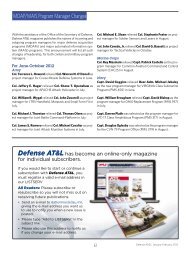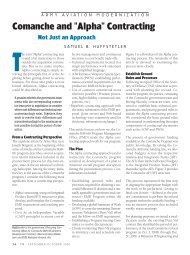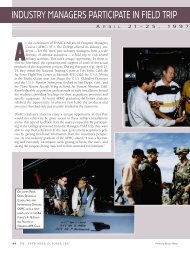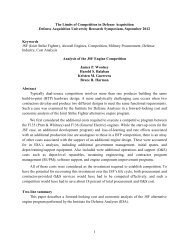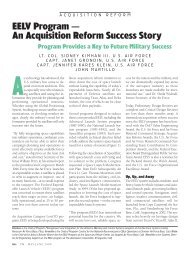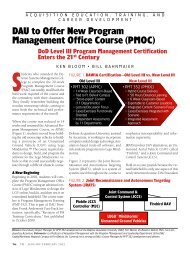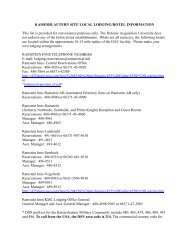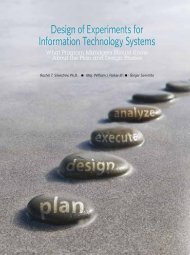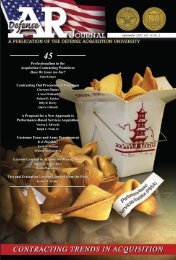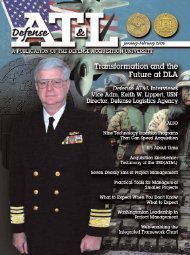Defense ARJ - Defense Acquisition University
Defense ARJ - Defense Acquisition University
Defense ARJ - Defense Acquisition University
Create successful ePaper yourself
Turn your PDF publications into a flip-book with our unique Google optimized e-Paper software.
<strong>Defense</strong> <strong>Acquisition</strong> Review Journal<br />
�<br />
�<br />
�<br />
�<br />
�<br />
�<br />
�<br />
�<br />
158<br />
Not true or false, but bad or good solutions. Solutions are politically, culturally,<br />
and psychologically charged, that is, they are infused with the sometimes<br />
hidden values of those in power or with influence; hence, unseen values judgments<br />
and intuition—not economic reasoning—can and will dominate.<br />
No immediate or ultimate test for unintended consequences. Because the<br />
situation is so complex, with variables that exhibit the dynamics of mutual<br />
causality, no one or no group can predict what will happen. The future years<br />
defense plan approach will likely be fraught with “type III error” (Mitroff &<br />
Kilmann, 1981)—unknowingly solving the wrong problem with precision.<br />
May have one shot only because of irreversible consequences. Even if the<br />
manager acts in committing resources to a single course of action, the dynamics<br />
of taking action itself will change the environment and the previous conditions<br />
will be irretrievable.<br />
No enumerable or exhaustive set of solutions. Courses of action can seem<br />
like bad or worse, or the lesser of two evils, or may even be incomprehensible—military<br />
planners metaphorically call this phenomenon the solving world<br />
hunger kind of impossible challenge, not unlike the intractable messes associated<br />
with prosecuting “irregular” warfare with conventional analytical models<br />
associated with the military decision-making process.<br />
Uniqueness. Restated, it is hard or impossible to find benchmarks or best<br />
practices from the past or other examples of success, historic anecdotes, doctrine,<br />
or documented lessons learned.<br />
Probably a symptom of another problem. There is no single problem but<br />
a systemic network of interactive and interdependent problems that is too<br />
complex to unravel.<br />
Discrepancy. The conceived gaps between ideal end and where managers<br />
perceive things are can be explained in numerous ways, and there is no<br />
systematic procedure to get to the right answer. This quality makes Cartesian<br />
solutions fruitless but gives political actors opportunity for framing a façade of<br />
technical rationality to convince voters to elect them.<br />
The planner, programmer, or budgeter has no right to be wrong. Albeit,<br />
they deal constantly with the reality of a large, complex adaptive system—or<br />
organized anarchy (Cohen, March, & Olson, 1972)—that experiences forever<br />
dynamic and unpredictable trajectories, fraught with ambiguity, and complex<br />
causal webs that defy the articulation of a desired end state or strategic objective<br />
(1973, pp. 161–166).<br />
The process of sensemaking reveals that the nature of the COE is not something<br />
managers have to deal with as external to their daily lives and the routine workings of<br />
the DoD. Indeed, managers and their organizations are both in it and interact within<br />
the interconnected workings of it in a dynamic, never-ending way. It is implausible,<br />
if not impossible, to isolate the world of PPBE against the backdrop of the hyperturbulent<br />
environment and the intervening world of the political players. This is



